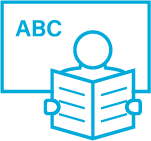The Role of Teaching Practices in the Development of Children’s Interest in Reading and Mathematics in Kindergarten
This study explored the extent to which teaching practices observed in kindergarten classrooms predict children’s interest in reading and mathematics. In classrooms where the teachers placed greater emphasis on child-centred teaching practices than on teacher-directed practices, the children showed more interest in reading and mathematics.
Authors: Marja-Kristiina Lerkkanen, Noona Kiuru, Eija Pakarinen, Jaana Viljaranta, Anna-Maija Poikkeus, Helena Rasku-Puttonen, Martti Siekkinen, & Jari-Erik Nurmi
Source: Lerkkanen, M-K., Kiuru, N., Pakarinen, E., Viljaranta, J., Poikkeus, A.-M., Rasku-Puttonen, H., Siekkinen, M. & Nurmi, J.-E. (2012). The role of teaching practices in the development of children’s interest in reading and mathematics in kindergarten. Contemporary Educational Psychology, 37, 266-279.
This study explored the extent to which teaching practices observed in kindergarten classrooms predict children’s interest in reading and mathematics. In classrooms where the teachers placed greater emphasis on child-centred teaching practices than on teacher-directed practices, the children showed more interest in reading and mathematics.
- Teachers’ instruction and classroom practices have been shown to contribute to children’s learning and academic outcomes.
- Less is known about the effects on children’s motivation toward academic subjects.
Defining interest in academic subjects
Motivation directs students’ behaviour and effort in learning situations.
Student interest in various school subjects and academic topics is of interest, as well as how much they like and enjoy doing tasks related to these topics.
Interest, intrinsic motivation, preference, and task motivation are concepts referring to this kind of interest.
Defining Achievement Goal Theory
Achievement goal theory refers to different kinds of goals and behaviour (such as mastery, performance-approach or performance-avoidance) thatdirect students’ engagement in achievement tasks.
Other concepts used to describe motivational patterns in academic environments are achievement beliefs, expectancies, and motivational strategies.
Defining child-centred practices
Children are recognised as active knowledge constructors. Teachers assist and facilitate children’s learning by providing them with guidance and opportunities to direct their own exploration of objects and academic topics, making teaching akin to a partnership between the teacher and the children. Practices include shared responsibility for management and learning, active teacher support for children’s learning efforts and social skills, and teaching practices that are sensitive to children’s needs and interests.
Defining teacher-directed practices
In this didactically-oriented kind of teaching, teachers emphasise the provision of information and employ structured, drill-and-practice group lessons that are fast-paced, teach discrete skills in small steps, and include praise when predetermined goals are reached. Teacher-controlled classrooms where the acquisition of ‘basic’ academic skills through oral recitation and worksheets are given considerable weight, whereas children’s interests and social skill development receive little attention and peer interaction is not applied.
The study
Teachers differ widely in their teaching practices and classroom instruction. The present study examined the extent to which teaching practices observed in kindergarten classrooms would predict children’s interest in reading and mathematics. We expected that child-centred teaching practices (being sensitive to children’s needs and interests) would increase children’s autonomy in initiating tasks and completing them, and by doing so, strengthen children’s interest in reading and mathematics.
Research questions:
- To what extent do kindergarten classrooms differ with respect to children’s interest in reading and mathematics?
- To what extent do observed teaching practices predict classroom differences identified in children’s interest in reading and mathematics, after controlling for classroom differences in pre-skills in reading and maths?
Participants were 515 kindergarten-aged children and their 49 teachers from 3 municipalities in Finland. Children’s pre-skills in reading and mathematics were investigated during the autumn and their interests were investigated during spring. Teachers were observed using the Early Childhood Classroom Observation Measure (ECCOM).
Findings
- It was found that 12% of the total variation in interest in reading and 4% of the interest in math was due to differences between kindergarten classrooms.
- The more child-centred and the less teacher-directed the observed teaching practices, the higher the reading motivation and interest in maths were among children in the particular classroom.
- The components ‘climate’ and ‘instruction’ relating to child-centred teaching practices were found to have the highest positive correlation with children’s interest.
- Climate included support for communication skills, interpersonal skills, student engagement, and individualisation of learning activities, while instruction included learning standards, coherence of instructional activities, teaching concepts, and instructional conversation.
- The associations between the observed teaching practices and interest were somewhat stronger in reading than in maths.
Implications
- Using child-centred practices in teaching, such as allowing children a lot of freedom to choose tasks and complete them without the pressure of getting the right answer, increases children’s motivation to study, which may lead to better academic achievements.
Examples of child-centred teaching practices
- Children are allowed to take responsibility to the degree they are able.
- There is a mixture of the teacher and children making choices.
- The teacher encourages children to engage in conversation and elaborate on their thoughts.
- The teacher provides opportunities for cooperative, small-group activities that promote peer interaction.
- The teacher is attentive to children’s individual skill level and adapts tasks accordingly.
- Attention is given to connections occurring between/within academic lessons.
- Tasks and lessons are designed to teach identifiable concepts and to develop comprehension.



